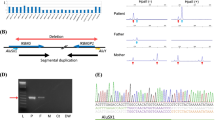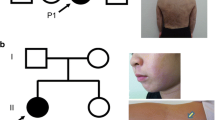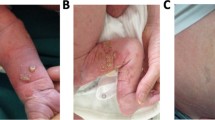Abstract
Incontinentia pigmenti is an X-linked genodermatosis, lethal in males. Affected females survive because of X-chromosome dizygosity and negative selection of cells carrying the mutant X-chromosome, and for this reason the skewed X inactivation pattern is often used to confirm the diagnosis. The most frequent mutation is a deletion of part of the NEMO gene (NEMOΔ4–10), although other mutations have been reported. Mutations of NEMO which do not abolish NF-κB activity totally permit male survival, causing an allelic variant of IP called hypohidrotic ectodermal dysplasia and immunodeficiency (HED-ID). We present a non-classical IP female patient who also suffered transient immunodeficiency because of a late and progressive selection against peripheral blood cells carrying an active mutated X-chromosome. This finding suggests that in the absence of known mutation the X-inactivation studies used in genetic counselling can induce mistakes with some female patients. At the age of 3 years and 6 months, all immunodeficiency signs disappeared, and the X-chromosome inactivation pattern was completely skewed. The low T cell proliferation and CD40L expression corroborate the important role of NEMO/ NF-κB pathway in T cell homeostasis. The decreased NEMO protein amount and the impaired IkBα degradation suggest that this new mutation, NM_003639: c.1049dupA, causes RNA or protein instability. To our knowledge, this is the first time that selection against the mutated X-chromosome in X-linked disease has been documented in vivo.





Similar content being viewed by others
References
Allen RC, Zoghbi HY, Moseley AB, Rosenblatt HM, Belmont JW (1992). Methylation of HpaII and HhaI sites near the polymorphic CAG repeat in the human androgen receptor gene correlates with X chromosome inactivation. Am J Hum Genet 51:1229–1239
Aradhya S, Courtois G, Rajkovic A, Lewis RA, Levy M, Israel A, Nelson DL (2001a) Atypical forms of incontinentia pigmenti in male individuals result from mutations of a cytosine tract in exon 10 of NEMO (IKK-γ). Am J Hum Genet 68:765–771
Aradhya S, Woffendin H, Jakins T, Bardaro T, Esposito T, Smahi A, Shaw C, Levy M, Munnich A, D’Urso M, Lewis RA, Kenwrick S, Nelson DL (2001b) A recurrent deletion in the ubiquitously expressed NEMO (IKK-γ) gene accounts for the vast majority of incontinentia pigmenti mutations. Hum Mol Genet 10:2171–2179
Courtois G, Smahi A, Reichenbach J, Doffinger R, Cancrini C, Bonnet M, Puel A, Chable-Bessia C, Yamaoka S, Feinberg J, Dupuis-Girod S, Bodemer C, Livadiotti S, Novelli F, Rossi P, Fischer A, Israel A, Munnich A, Le Deist F, Casanova JL (2003) A hypermorphic IkappaBalpha mutation is associated with autosomal dominant anhidrotic ectodermal dysplasia and T cell immunodeficiency. J Clin Invest 112:1108–1105
de Vries E, de Bruin-Versteeg S, Comans-Bitter WM, de Groot R, Hop WC, Boerma GJ, Lotgering FK, van Dongen JJ (2000). Longitudinal survey of lymphocyte subpopulations in the first year of life. Pediatr Res 47:528–537
Fusco F, Bardaro T, Fimiani G, Mercadante V, Miano MG, Falco G, Israel A, Courtois G, D’Urso M, Ursini MV (2004) Molecular analysis of the genetic defect in a large cohort of IP patients and identification of novel NEMO mutations interfering with NF-κB activation. Hum Mol Genet 13:1763–1763
Hadj-Rabia S, Froidevaux D, Bodak N, Hamel-Teillac D, Smahi A, Touil Y, Fraitag S, de Prost Y, Bodemer C (2003) Clinical study of 40 cases of incontinentia pigmenti. Arch Dermatol 139:1163–1170
Heine-Suner D, Torres-Juan L, Morla M, Busquets X, Barcelo F, Pico G, Bonilla L, Govea N, Bernues M, Rosell J (2003) Fragile-X syndrome and skewed X-chromosome inactivation within a family: a female member with complete inactivation of the functional X chromosome. Am J Med Genet 122:108–114
International IP Consortium (2000) Genomic rearrangement in NEMO impairs NF-κB activation and is a cause of incontinentia pigmenti. The International Incontinentia Pigmenti (IP) Consortium. Nature 405:466–472
Israel A (2000) The IKK complex an integrator of all signals that activate NF-κB? Trends Cell Biol 10:129–133
Jain A, Ma CA, Liu S, Brown M, Cohen J, Strober W (2001) Specific missense mutations in NEMO result in hyper-IgM syndrome with hypohidrotic ectodermal dysplasia. Nature Immunol 2:223–228
Janssen R, van Wengen A, Hoeve MA, ten Dam M, van der Burg M, van Dongen J, van de Vosse E, van Tol M, Bredius R, Ottenhoff TH, Weemaes C, van Dissel JT, Lankester A (2004) The same IkappaBalpha mutation in two related individuals leads to completely different clinical syndromes. J Exp Med 200(5):559–568
Kosaki K, Shimasaki N, Fukushima H, Hara M, Ogata T, Matsuo N (2001) Female patient showing hypohidrotic ectodermal dysplasia and immunodeficiency (HED-ID). Am J Hum Genet 69:664–665
Landy SJ, Donnai D (1993) Incontinentia pigmenti (Blosch–Sulzberger syndrome). J Med Genet 30:53–59
Makris C, Roberts JL, Karin M (2002). The carboxyl-terminal region of IkappaB kinase gamma (IKKgamma) is required for full IKK activation. Mol Cell Biol 22:6573–6581
Niehues T, Reichenbach J, Neubert J, Gudowius S, Puel A, Horneff G, Lainka E, Dirksen U, Schroten H, Doffinger R, Casanova JL, Wahn V (2004) Nuclear factor kappaB essential modulator-deficient child with immunodeficiency yet without anhidrotic ectodermal dysplasia. J Allergy Clin Immunol 114:1456–1462
Nishikomori R, Akutagawa H, Maruyama K, Nakata-Hizume M, Ohmori K, Mizuno K, Yachie A, Yasumi T, Kusunoki T, Heike T, Nakahata T (2004) X-linked ectodermal dysplasia and immunodeficiency caused by reversion mosaicism of NEMO reveals a critical role for NEMO in human T-cell development and/or survival. Blood 103:4565–4572
Orange JS, Levy O, Brodeur SR, Krzewski K, Roy RM, Niemela JE, Fleisher TA, Bonilla FA, Geha RS (2004) Human nuclear factor kappa B essential modulator mutation can result in immunodeficiency without ectodermal dysplasia. J Allergy Clin Immunol 114:650–656
Parrish JE, Scheuerle AE, Lewis RA, Levy ML, Nelson DL (1996). Selection against mutant alleles in blood leukocytes is a consistent feature in Incontinentia Pigmenti type 2. Hum Mol Genet 5:1777–1783
Rothwarf DM, Zandi E, Natoli G, Karin M (1998) IKK-γ is essential regulatory subunit of the IκB kinase complex. Nature 395:297–300
Sharp A, Robinson D, Jacobs P (2000) Age- and tissue-specific variation of X chromosome inactivation ratios in normal women. Hum Genet 107(4):343–349
Schmidt-Supprian M, Bloch W, Courtois G, Addicks K, Israel A, Rajewsky K, Pasparakis M (2000) NEMO/IKK gamma-deficient mice model incontinentia pigmenti. Mol Cell 5:981–992
Schmidt-Supprian M, Courtois G, Tian J, Coyle AJ, Israel A, Rajewsky K, Pasparakis M (2003) Mature T cells depend on signalling through the IKK complex. Immunity 19:377–389
Sulzberger MB (1993) Incontinentia pigmenti (Blosch–Sulzberger syndrome): a report of an additional case, with comment on possible relation to a new syndrome of familial and congenital abnormalies. Arch Dermatol 38:57–69
Zonana J, Elder ME, Schneider LC, Orlow SJ, Moss C, Golabi M, Shapira SK, Farndon PA, Wara DW, Emmal SA, Ferguson BM (2000) A novel X-linked disorder of immune deficiency and hypohidrotic ectodermal dysplasia is allelic to incontinentia pigmenti and due to mutations in IKK-gamma (NEMO). Am J Hum Genet 67:1555–1562
Acknowledgements
We wish to thank Dr. Joana Ferrer, Dr. Aitziber Etxagibel and Dr. Jaume Pons for their comments and help in the redaction of the early manuscript.
Author information
Authors and Affiliations
Corresponding author
Rights and permissions
About this article
Cite this article
Martinez-Pomar, N., Munoz-Saa, I., Heine-Suner, D. et al. A new mutation in exon 7 of NEMO gene: late skewed X-chromosome inactivation in an incontinentia pigmenti female patient with immunodeficiency. Hum Genet 118, 458–465 (2005). https://doi.org/10.1007/s00439-005-0068-y
Received:
Accepted:
Published:
Issue Date:
DOI: https://doi.org/10.1007/s00439-005-0068-y




